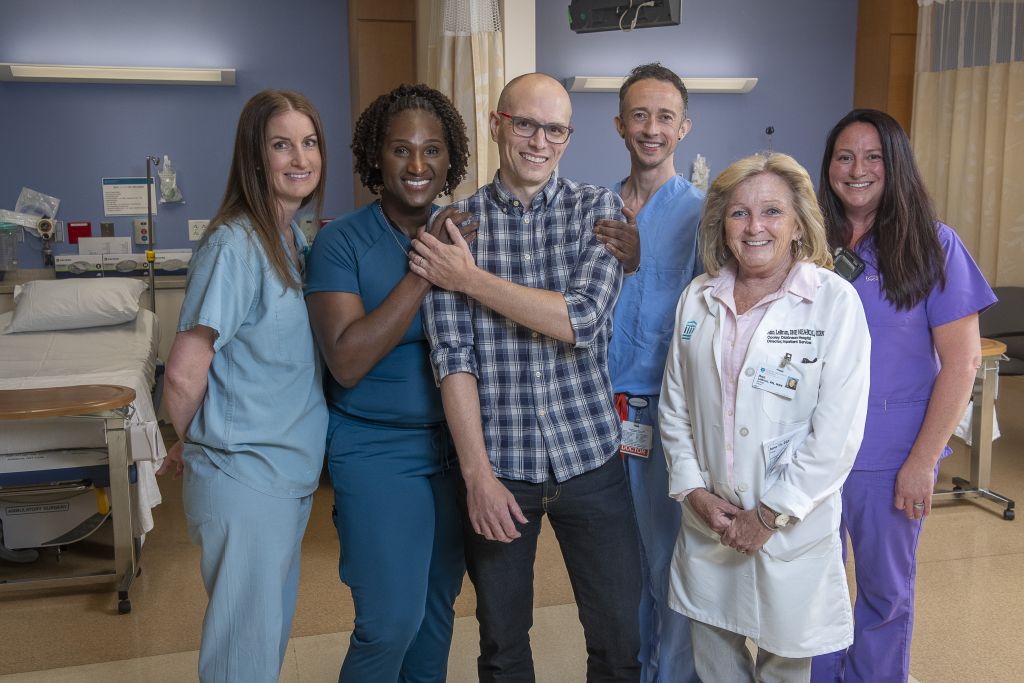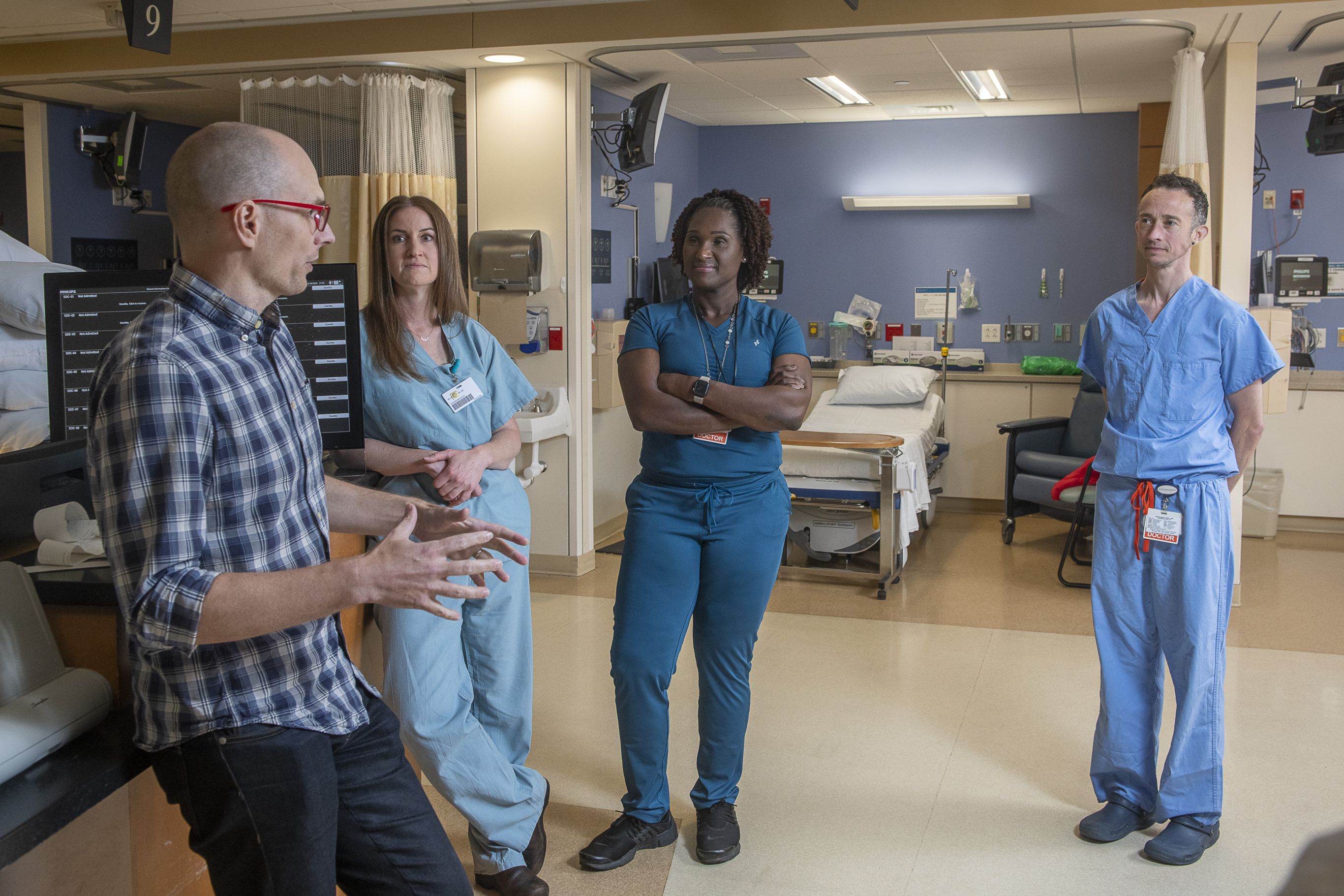July 23, 2024
July 23, 2024
Monday, April 1, 2024 is a day that Florence resident Tim Johnson will never forget. He checked into the Cooley Dickinson Hospital Emergency Department vomiting massive amounts of blood and received what he – and his team of doctors – describe as life-saving care after an artery along the wall of his stomach ruptured. Prioritized to be high risk, Tim’s ER team, led by Emergency Department physician Adrian Daul, MD, put a plan in place that would prepare Tim for emergency surgery.
“After passing out in the ED, I awoke to a room already swarming with medical professionals,” recalled Tim, a 43-year-old father of two. “I could hear the professionalism in their voices as well as the deep concern for my life.”
More than two months later, Tim returned to Cooley Dickinson Hospital to talk about his experience with a few members of his care team: surgeons Ursula McMillian, MD and Michelle Helms, MD; Dr. Daul; ICU Registered Nurse Kate Ring, RN and Nursing Supervisor Ann LeBrun, DNP, RN.

Recalled Dr. McMillian, “This case was nothing short of a miracle. Tim is lucky to be alive today.”
Tim’s “second chance” has given him a new perspective. He says it is easy to take for granted the full scope of expertise that resides in the hospital, the full scope of talented and dedicated medical personnel that live in our community, and how prepared the hospital is to handle the unexpected.
“I hope those reading this never need as much care as I received from Cooley Dickinson, but I also hope they feel heartened to know that world-class, life-saving care is right here in our community.”
In his own words: Read the Q&A with Tim Johnson
What were you doing prior to going to the Emergency Department at Cooley Dickinson. What were your symptoms?
I was working at home and had just eaten when my stomach started to feel very full. Within about 5 minutes I was throwing up large amounts of blood.
Do you know what caused this to happen?
The cause was a gastrointestinal hemorrhage known as a Dieulafoy lesion. According Dr. McMillian, who led the surgical team that discovered the bleed, a Dieulafoy lesion is an abnormal arteriovenous malformation that may be present in the layer below the mucus membranes in the gastrointestinal tract. The lesion causes a connection between the artery and vein and if it ruptures it can cause large volume arterial bleeding. Dr. McMillian says this condition is rare and potentially life-threatening, if it is not treated surgically.
During your recovery earlier this spring, you were preparing letters of thanks to many of the people who cared for you. What are your messages to them?
I am so grateful to Dr. Daul for his quick response in the ER; he stayed a step ahead of the situation and that gave me every chance I needed to survive. Dr. Ganz did her very best to try and repair the bleed endoscopically and stayed with me while I was transported to surgery. Surgeons Dr. Helms and Dr. McMillian worked tirelessly to find and repair the bleed over the course of a few hours. It took them a long time to isolate the source of the bleed and I am so grateful they stuck with me and kept trying until they found the source and stopped it.
During these interventions there were dozens of other people helping to keep me alive – many of whom I will never be able to recognize, but I think about them daily, especially the blood donors who supplied the blood for the many transfusions I received.
What happened after your emergency surgery?
After surgery, I spent 5 days in the CCU and the 3 days I was in the Med Surg for recovery. There were many aides, nurses, phlebotomists, food service staff, and custodial staff who looked after me and took care of me. They made me feel safe and often took time to just chat with me, which made me feel human.
How has this experience changed your outlook on life, work and family?
Even though it is the ideal outcome, it’s strange to go through something so serious, scary, and life threatening and have it work out. It can feel like a dream at times… and I think that is the best possible outcome. It is a wonderful blessing to be granted a second chance, and I welcome a return to normalcy.
I do keep waiting for the “aha” moment of change, but it has not arrived. I’m still the same person I was before, just maybe a bit more grateful for sunshine on my skin, dirt under my fingernails, laughing with my kids, and spending time with my wife. I still love being a parent and spouse. I still love working and the work that I do as a nonprofit professional; it’s a privilege to run an organization and Native Plant Trust’s staff and Trustees have been immensely supportive of my recovery. It feels sometimes like I should want everything to change, but I always settle back into actually loving the life I have now because I loved my life already.
I do feel a deeper fondness for the community that has welcomed us here and deep gratitude for the family, friends, and colleagues who showed up to support me and my family in many ways.
If one thing has changed, it is that I’m being less shy about letting the people I love know that I love them.
You lost a lot of blood and also received many units of blood during and after your surgery. What is your message to blood donors in our community?
The bleed in my stomach was profuse. I received approximately 15 units of blood and additional blood products during my surgery meaning nearly all my blood was replaced with blood from donors. These transfusions kept my blood pressure up, my heart beating, and my organs functioning, buying critical time while the surgeons hunted for the bleed. After my surgery I received additional transfusions to increase my red blood cell count.
I never thought I would need a blood transfusion ever in my life. I’m guessing no one does. A normal blood donor can only give blood 6 times a year, giving a single unit each time. Human blood is such an incredibly precious resource–it cannot be mined, grown, or engineered. It can only be made in the human body. We only have it when we need it because donors are willing to donate before it is needed. I wish I could thank every one of the generous blood donors in our community personally. I would not be here without them.
What else would you like to add?
I’ve driven by Cooley Dickinson Hospital thousands of times. It’s easy to take for granted the full scope of expertise that resides in the hospital, the full scope of talented and dedicated medical personnel that live in our community, and how prepared the hospital is to handle the unexpected.
The day after I was admitted to the hospital, as my wife was walking across the parking lot to come see me, Dr. Daul was arriving for work and ran up to her to ask how I was. He told her two things that meant the world to her. The first was that he had planned to check on me as soon as he arrived. The second was that the care I received was “an example of a community hospital at its very best.”
When I was discharged from the hospital, I stopped by the ER to thank Dr. Daul. When I arrived in the ER, I was surprised to see so many staff I didn’t recognize looking at me and smiling as if they knew who I was and what I had gone through. I think it was then that the full scope of the ordeal I had been through and the sheer number of people and the full extent of resources that the hospital had collectively invested in me really sunk in. Everyone was rooting for me. I had this incredible feeling from them of hope realized and I knew that keeping me alive and fixing me up was personal to them.
When Dr. Daul spotted me waiting for him, he turned away for a moment (maybe a little shocked to see me) and when he looked at me, I saw in his face such relief and happiness. With a bit of effort, I stood up to hug him and through tears thanked him for saving my life, for making my care a priority, for taking it personally. He deflected, sharing the credit with the many hands that helped me. As we hugged, he said, “let’s meet up again, but maybe on a park bench.”


